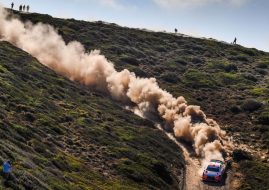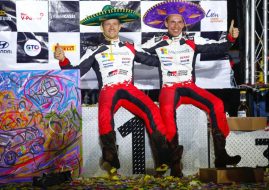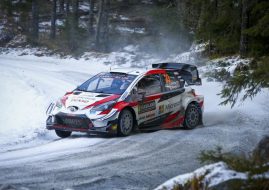MG Metro 6R4 - Unique Group B Monster
We already know everything about legendary Group B rally cars that conquered the world (Lancia Rally 037, Audi Quattro, Peugeot 205 T16, Ford RS200), but now it’s time to introduce you to one more Group B legend which didn’t win a single WRC rally, but is still considered as one of the most important cars in the history of world rallying. We are talking about the MG Metro 6R4, an ugly little beast from Great Britain which competed in the World Rally Championship in 1985 and 1986the last two years of the Group B cars.
It’s ugly, but the best car I’ve ever driven – said Tony Pond
“I know it’s an ugly beast, but the 6R4 is easily the best rally car I’ve ever driven. Enormous power with a four-wheel-drive traction was a brilliant combination, but the transmission also brought other advantages in grip, stability and braking. Aerodynamics performance, too, was an area where the car was a pioneer, as other manufacturers had always believed rallying speeds weren’t high enough for wings to work.” These were the words from the renowned British rally ace Tony Pond, who participated in the creation of the 6R4 as a test driver and achieved the best result with that car in WRC, finishing third at the 1985 Lombard RAC Rally.

Tony Pond with the car which he helped to be created
Podium for Metro at the debut WRC event
That was the first international rally of the brand new rally car and Tony Pond immediately achieved a podium position. Unfortunately, the positive start wasn’t repeated and a third place remained the best result of the MG Metro 6R4 during its short WRC history.
In the 1986 season, which was the last season of Group B rally cars, many renowned drivers were a part of the Austin Rover factory team – Tony Pond, Malcolm Wilson, Per Eklund, Marc Duez, Didier Auriol, Jimmy McRae, Harri Toivonen and David Llewellin. The season was marked by many mechanical problems and retirements, and the best result was Malcolm Wilson’s fourth place at the Rally Sanremo.

The 3.0-liter 6-cylinder engine, which made Metro 6R4 completely different from other Group B rally cars
V6 specially produced for rallying
We have to go all the way to the beginning of the story of the MG Metro 6R4 to see why the car was so special among all the others. The name of the car is simply symbolical – 6 is the number of cylinders, R means Rally and 4 is for the four-wheel-drive. At the time, all other Group B rally cars had four-cylinder engines with turbo, but Britons made it differently – they used a 3-liter V6 engine. This engine was specially produced for rallying purposes and didn’t have an origin in a road car engine, like other manufacturers had.
Idea was born in 1980
The idea of a high-performance rally car from British Leyland Motorsport was born in 1980, after its previous rally car Triumph TR7 V8 was retired. In 1981, Williams GP Engineering was chosen as the partner for the developing of the new car. After much discussion, the decision was made that the base car will be the little Metro. The first idea of the front-engined V8 rear-wheel drive car was rejected and they chose the mid-engined V6 four-wheel-drive concept.
Combining the benefits of both the Audi Quattro (four wheel drive) and Renault 5 Turbo (mid-engined), Metro’s powerplant was to be the biggest decision against the trend. With a large capacity normally aspirated engine, they wanted to avoid the power lag, heat and engineering problems associated with turbocharged engines.

Tony Pond testing the prototype of the new rally car (1984)
V64V had over 400 hp
The first original prototype of the Rover’s 2.5-liter V6 turned up in February 1983, driven by Tony Pond. In early 1984, the new car was officially named Metro 6R4 and after that the prototype was used for testing in real conditions at national rallies. In February 1985, the Metro 6R4 won its first rally – the Skip Brown Cars Gwynedd Rally, although with first version of V6 engine. All that the team was now waiting for was to get their hands on the new engine.
The 3-liter Austin Rover V64V, designed by ex-Cosworth employee David Wood, was a 90-degree V6 with 4 valves per cylinder (hence V64V), with belt-driven twin-overhead camshafts per bank producing either 250 bhp in ‘Clubman’ form or 380/410 bhp in ‘International’ tune.
200 cars were built for homologation
The car was presented to the press in May 1985, when Tony Pond and Marc Duez took invited journalists for a ride. With the layout, design and specification virtually resolved, the next goal was to get the car homologated in time for the proposed World Rally Championship debut in the 1985 Lombard RAC Rally. During August to October 1985, Austin Rover built (and had inspected by FISA) 200 MG Metro 6R4s, successfully homologating the car into Group B.

Tony Pond in MG Metro 6R4 at the 1986 Rallye Monte-Carlo
Patriotic debut for 6R4 at the 1985 Lombard RAC Rally
The 6R4 appeared in two guises. The first was the road-going version Clubman, which developed 250 bhp and was sold to the public for £40,000. With some simple additions, the car was ‘ready to rally’. Further 20 were taken and built to International specifications which had a recorded output of over 410 bhp. Those cars were used in the World Rally Championship.
With the whole nation behind them, Tony Pond and Malcolm Wilson (partnered by co-drivers Rob Arthur and Nigel Harris) made a patriotic debut in the 1985 Lombard RAC Rally. Tony Pond finished 3rd overall behind the two Lancia Delta S4s (also on their Group B debut). Malcolm Wilson retired with transmission problems.
French and British rally champion
After an impressive debut, optimism was high for the 1986 season but the results did not match the expectations. 6R4’s reliability was bad and the drivers rarely finished the events. It was quite a different story in other international and national rallies, where the pace and length weren’t as tough as in WRC, so 6R4 won many races and a few championship titles. For example, Didier Auriol won the 1986 French National Championship and Alistair Sutherland became the British Rally Champion.

Alistair Sutherland was the 1986 British rally champion with MG Metro 6R4
Metro 6R4 was perfect for rallycross
In 1987, Group B rally cars were banned and that resulted in the creation of the problem of what to do with those cars. British motor racing authorities agreed to let the cars compete in British national rallies but with reduced power. On the other hand, the original Group B rally cars were perfect for rallycross, without a decrease in power. Some owners even resorted to turbocharging the V64V engine and getting more than 700 bhp. The most successful was Will Gollop, who became the European Rallycross Champion in 1992.
So, in conclusion, the MG Metro 6R4 deserved its place in the history books as a car with a different concept. Though the rally car was a little bit too late for the World Rally Championship, it was also one of the most successful national rally cars ever.
Video: MG Metro 6R4 in Group B Rally
Photos: 6R4.net.







